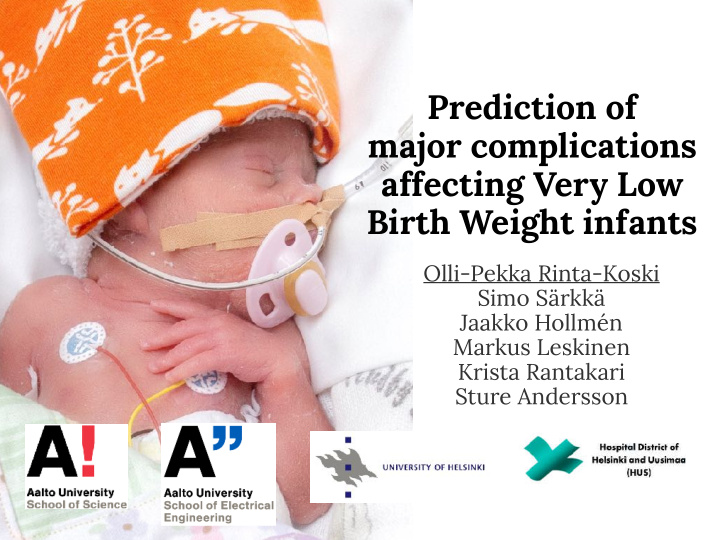



Prediction of major complications affecting Very Low Birth Weight infants Olli-Pekka Rinta-Koski Simo Särkkä Jaakko Hollmén Markus Leskinen Krista Rantakari Sture Andersson
Goal of this paper Time series prediction of 3 major complications affecting preterm infants Aims of the project Study of vital trends Oxygen saturation, supplementary oxygen, blood pressure, • respiration, nutrition & growth A look at prediction opportunities What can we predict, using what data, and how early? • Intended outcomes Quality control, better resource allocation, improved quality of care •
Background ● Neonatal Intensive Care Unit (NICU) at the Helsinki University Children's Hospital treats 120–150 Very Low Birth Weight (VLBW, birth weight <1500 g) infants/year ● Patient data collection started 1999 ● We have studied 2059 VLBW infants treated in 1999–2013
Description of the data 2059 VLBW infants born in 1999–2013 − Median gestational age 202 days (~29 weeks), birth weight 1105 g − Median length of NICU stay 14.2 days − 185 patients (9%) died in the NICU, median age at death 5 days 175 GB of timestamped data Sensor output ● heart rate, respiratory rate, oxygen saturation, blood pressure, body temperature ● 2 minute averages Manual observations ● length, weight, head circumference Care parameters ● diagnoses, medication, nutrition
Diagnoses Bronchopulmonary dysplasia (BPD) − Problem with immature lung development − Related to oxygen saturation − Diagnosed at 28 days − Results in significant morbidity and mortality Retinopathy of prematurity (ROP) − Problem with immature eye (retina) development − Related to oxygen saturation: too much O 2 -> patient develops ROP (blindness), too little O 2 -> patient dies Necrotizing enterocolitis (NEC) − Intestinal tissue death − Develops during NICU stay − Diagnosis requires radiography (X-ray imaging) − 2nd most common cause of preterm infant mortality
Data and methods ● Features used ● Clinical values/scores determined at or near time of birth: gestational age, birth weight, SNAP-II, SNAPPE-II ● 24h/72h time series data: systolic/mean/diastolic arterial blood pressure, ECG heart rate, ���������������� ��������� oxygen saturation (SpO 2 ) ��� ● Diagnoses ● 20% BPD, 3% NEC, ��� ����� ������ ���� 7% ROP � ● Classification ��� ● Binary classification: ��� likely/not likely to be affected �� ��������� ��� ��������� ● Benchmark: ��� ��� ��� ��� ��� ��� ��� ��� ��� ��� ����������� ��� ������ SNAP(PE)-II thresholding
Gaussian process ( CC BY-SA 4.0 Cdipaolo96 ) • “Gaussian process” = a set of random variables where the joint distribution of any (finite) subset is a Gaussian • Defined by mean function µ (x) and covariance matrix k ( x , x’ ) GP can be used to find a distribution over functions f(x) consistent with the observed data
GP classification: parameters used ● GPstuff – Matlab/Octave/R toolbox http://research.cs.aalto.fi/pml/software/gpstuff/ ● classifier = GP with a probit measurement model ● 2 classes: ● kernel = squared exponential (RBF) + linear + constant
Prediction results BPD NEC AUC 0.87 AUC 0.74 PPV 0.67 PPV 0.11 Sens 0.52 Sens 0.17 ROP AUC 0.84 PPV 0.50 Sens 0.05
Summary and conclusions ● GP classification using time series data from the first hours of NICU care outperforms SNAP(PE)-II for predicting VLBW infant susceptibility to BPD ● Time series prediction accuracy can be improved with features/scores determined at birth, but… ● …conditions that develop during treatment will in general require on-line monitoring analysis Future work ● Prediction of other diagnoses and patient deterioration ● Integration of machine learning in NICU care processes ● Prediction of patient post-NICU development
Recommend
More recommend